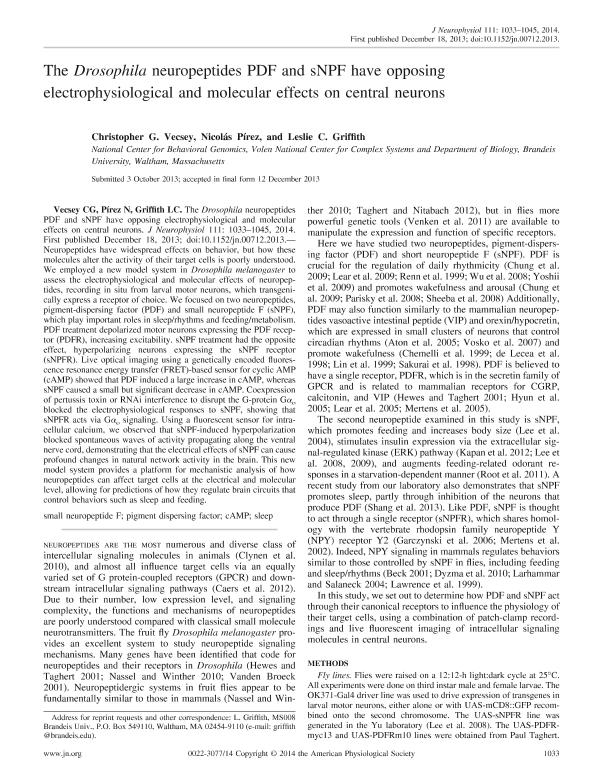Mostrar el registro sencillo del ítem
dc.contributor.author
Pírez, Nicolas

dc.contributor.author
Vecsey, Christopher G.
dc.contributor.author
Griffith, Leslie C.
dc.date.available
2016-11-24T14:43:57Z
dc.date.issued
2014-03
dc.identifier.citation
Pírez, Nicolas; Vecsey, Christopher G.; Griffith, Leslie C.; The Drosophila Neuropeptides PDF and sNPF Have Opposing Electrophysiological and Molecular Effects on Central Neurons; American Physiological Society; Journal Of Neurophysiology; 111; 5; 3-2014; 1033-1045
dc.identifier.issn
0022-3077
dc.identifier.uri
http://hdl.handle.net/11336/8339
dc.description.abstract
Neuropeptides have widespread effects on behavior, but how these molecules alter the activity of their target cells is poorly understood. We employed a new model system in Drosophila melanogaster to assess the electrophysiological and molecular effects of neuropeptides, recording in situ from larval motor neurons, which transgenically express a receptor of choice. We focused on two neuropeptides, pigment-dispersing factor (PDF) and small neuropeptide F (sNPF), which play important roles in sleep/rhythms and feeding/metabolism. PDF treatment depolarized motor neurons expressing the PDF receptor (PDFR), increasing excitability. sNPF treatment had the opposite effect, hyperpolarizing neurons expressing the sNPF receptor (sNPFR). Live optical imaging using a genetically encoded fluorescence resonance energy transfer (FRET)-based sensor for cyclic AMP (cAMP) showed that PDF induced a large increase in cAMP, whereas sNPF caused a small but significant decrease in cAMP. Coexpression of pertussis toxin or RNAi interference to disrupt the G-protein Gαo blocked the electrophysiological responses to sNPF, showing that sNPFR acts via Gαo signaling. Using a fluorescent sensor for intracellular calcium, we observed that sNPF-induced hyperpolarization blocked spontaneous waves of activity propagating along the ventral nerve cord, demonstrating that the electrical effects of sNPF can cause profound changes in natural network activity in the brain. This new model system provides a platform for mechanistic analysis of how neuropeptides can affect target cells at the electrical and molecular level, allowing for predictions of how they regulate brain circuits that control behaviors such as sleep and feeding.
dc.format
application/pdf
dc.language.iso
eng
dc.publisher
American Physiological Society

dc.rights
info:eu-repo/semantics/openAccess
dc.rights.uri
https://creativecommons.org/licenses/by-nc-sa/2.5/ar/
dc.subject
Camp
dc.subject
Pigment Dispersing Factor
dc.subject
Sleep
dc.subject
Small Neuropeptide F
dc.subject.classification
Otros Tópicos Biológicos

dc.subject.classification
Ciencias Biológicas

dc.subject.classification
CIENCIAS NATURALES Y EXACTAS

dc.title
The Drosophila Neuropeptides PDF and sNPF Have Opposing Electrophysiological and Molecular Effects on Central Neurons
dc.type
info:eu-repo/semantics/article
dc.type
info:ar-repo/semantics/artículo
dc.type
info:eu-repo/semantics/publishedVersion
dc.date.updated
2016-11-18T15:20:26Z
dc.journal.volume
111
dc.journal.number
5
dc.journal.pagination
1033-1045
dc.journal.pais
Estados Unidos

dc.journal.ciudad
Bethesda
dc.description.fil
Fil: Pírez, Nicolas. Consejo Nacional de Investigaciones Científicas y Técnicas. Oficina de Coordinación Administrativa Parque Centenario. Instituto de Investigaciones Bioquimicas de Buenos Aires; Argentina. Brandeis University. Department of Biology; Estados Unidos
dc.description.fil
Fil: Vecsey, Christopher G.. Brandeis University. Department of Biology; Estados Unidos
dc.description.fil
Fil: Griffith, Leslie C.. Brandeis University. Department of Biology; Estados Unidos
dc.journal.title
Journal Of Neurophysiology

dc.relation.alternativeid
info:eu-repo/semantics/altIdentifier/url/http://jn.physiology.org/content/111/5/1033.article-info
dc.relation.alternativeid
info:eu-repo/semantics/altIdentifier/doi/http://dx.doi.org/10.1152/jn.00712.2013
dc.relation.alternativeid
info:eu-repo/semantics/altIdentifier/url/https://www.ncbi.nlm.nih.gov/pmc/articles/PMC3949227/
Archivos asociados
